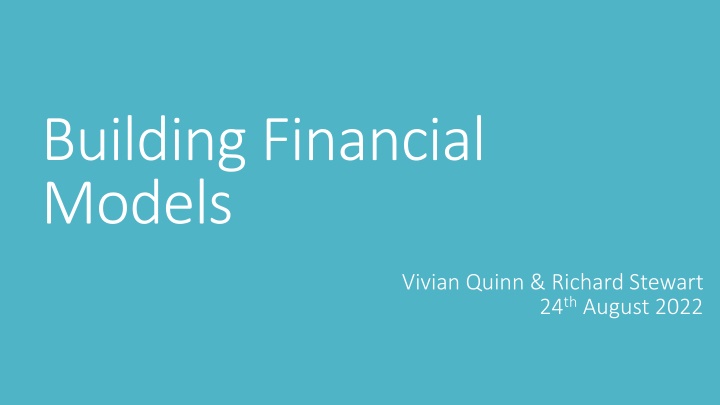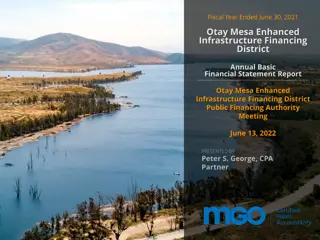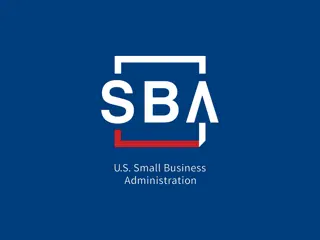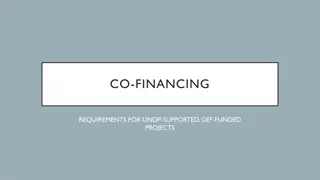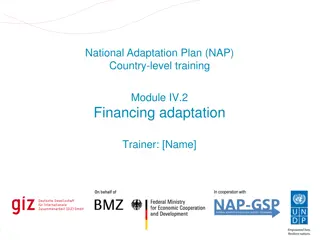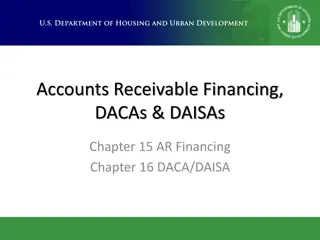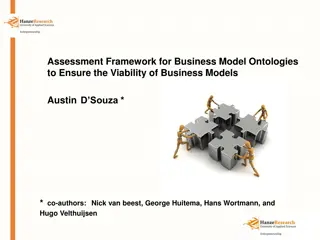Building Financial Models - Implementation, Financing, and Business Plan Criteria
Today's session involves mentor consultations on implementation, financing, competitor analysis, and market sizing for financial viability. Explore Lean Canvas, financial model significance, and key assessments in the business plan criteria focusing on idea quality, implementation strategy, and potential investor perspectives.
Download Presentation

Please find below an Image/Link to download the presentation.
The content on the website is provided AS IS for your information and personal use only. It may not be sold, licensed, or shared on other websites without obtaining consent from the author.If you encounter any issues during the download, it is possible that the publisher has removed the file from their server.
You are allowed to download the files provided on this website for personal or commercial use, subject to the condition that they are used lawfully. All files are the property of their respective owners.
The content on the website is provided AS IS for your information and personal use only. It may not be sold, licensed, or shared on other websites without obtaining consent from the author.
E N D
Presentation Transcript
Building Financial Models Vivian Quinn & Richard Stewart 24thAugust 2022
Todays sessions with your mentors Implementation and Financing Consultations Implementation and Financing Consultations Competitor analysis on your idea Research and document the possible market size and scalability of your ideas Is it financially viable? Is it financially viable?
Financial Models Why do we do them? How can they be used? What do the judges look for?
Business Plan Assessment Criteria 1. Quality of the idea 1. Quality of the idea 25% weighting 25% weighting a) What problem does your offering solve? b) What is your product or service offering and how does it work? c) What is the market for this idea? d) What is your unique value proposition and why does your offering solve the problem better than its potential competitors? e) Can the associated intellectual property be protected?
Business Plan Assessment Criteria 2. Implementation of the idea in a business context 2. Implementation of the idea in a business context - - 25% weighting a) How will you market the offer? 25% weighting b) What is the intended manufacturing or service delivery process? c) How will it be distributed or provided? d) Is there any environmental impact associated with the product or service? e) What are the key strengths/weaknesses of the team proposing the idea?
Business Plan Assessment Criteria 3. The investment (from a potential investor's point of view, would I put my money into 3. The investment (from a potential investor's point of view, would I put my money into this?) this?) - - 50% weighting 50% weighting a) How much investment is required? b) How will your business make money? c) What return on investment is forecast? d) How long will it take to pay back the investment? e) What are the key risks as you see them and how do you intend to mitigate against those risks?
Financial Modelling Document the rationale for the key assumptions Prepare a base case scenario using the most likely key assumptions First 12 months is detailed, subsequent 2-4 years less detailed Test the sensitivity of key assumptions e.g., growth; price sensitivity; FX Run scenarios based on variations to the key assumptions Calculate Net Present Value and Payback on each of the above scenarios Provide a financial perspective of the business
Best Practice Separate worksheets for: Contents (with links to other worksheets); Executive Summary; Assumptions; Sensitivity Analysis on key assumptions; 3-5 year projected Profit & Loss; 3-5 year projected Balance Sheet; 3-5 year Cash Flow projections.
Appendices - max 10 pages Start-up costs Projected sales Personnel plan Start-up funding Projected profit and loss statement Projected balance sheet Projected cash flow statement
Financial Templates Start-up costing A start-up costing sheet can help determine how much money you need to start. Cash flow statement A cash flow statement tracks all the money flowing in and out of your business and can reveal payment cycles or seasonal trends that require additional cash to cover payments. Profit and loss statement A profit and loss or income statement lists your sales and expenses and helps you work out how much real profit you're making. Balance sheet A balance sheet is a snapshot of your business on a particular date. It lists all of your business' assets and liabilities and works out your net assets. Financial calculators Use this template to calculate your key financial ratios and help you analyse the financial health of your business. Glossary of key financial terms Find definitions for financial terms that you may come across when you are dealing with accountants and financial institutions, or while running your business. Source: https://www.business.gov.au/info/plan Source: https://www.business.gov.au/info/plan- -and and- -start/templates start/templates- -and and- -tools tools
Financial Templates Google business plan excel template to search for useful sites such as: Google business plan excel template to search for useful sites such as: http://www.spreadsheet123.com/ExcelTemplates/financial http://www.spreadsheet123.com/ExcelTemplates/financial- -plan standard five year financial projection standard five year financial projection plan- -projection.html projection.html for a for a http://www.buzinga.com.au http://www.buzinga.com.au projections specifically for App Development projections specifically for App Development https://www.ato.gov.au/Business/Small https://www.ato.gov.au/Business/Small- -business information/Small information/Small- -business business- -benchmarks business benchmarks business benchmarks business- -benchmarks/In benchmarks/In- -detail/Related benchmarks- -methodology methodology- -and detail/Related- - ratio- -calculations/ calculations/ for small and- -ratio for small
